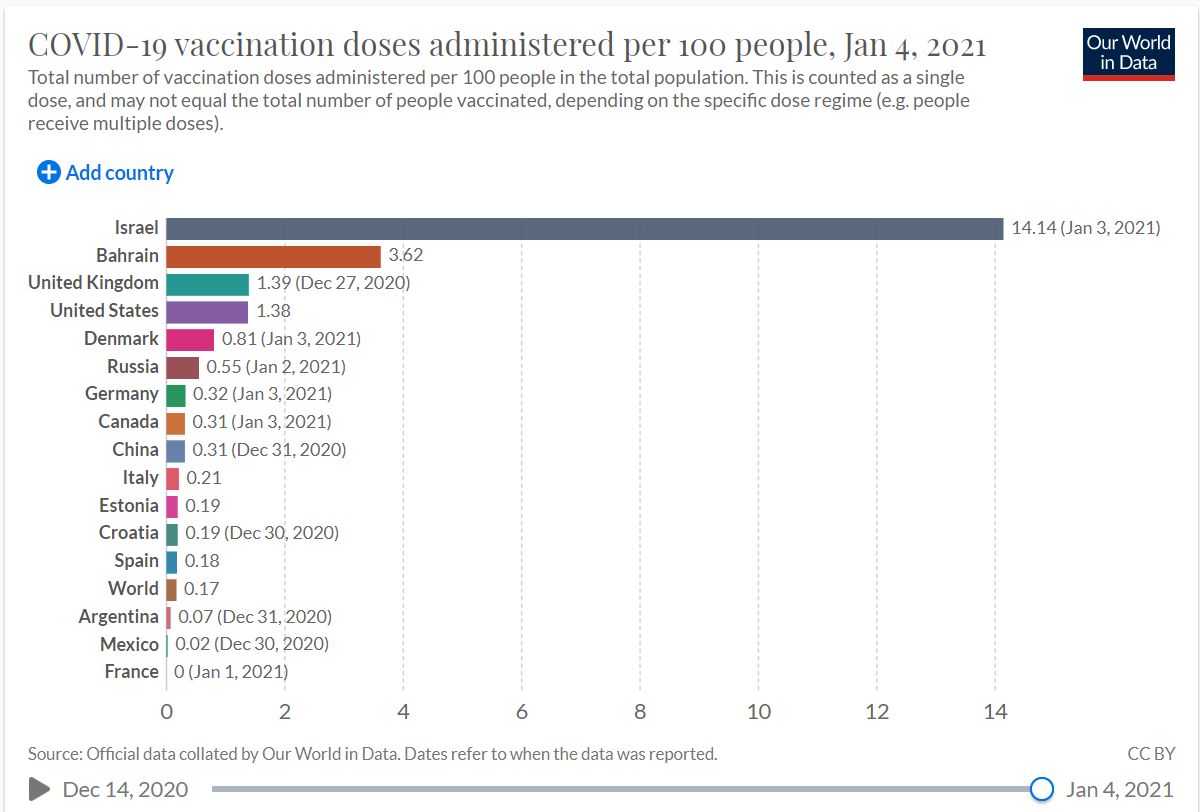Copy-editor: Rob Camp
Vaccine
De Vrieze J. Suspicions grow that nanoparticles in Pfizer’s COVID-19 vaccine trigger rare allergic reactions. Science 2020, published 21 December (sorry for being late!). Full-text: https://www.sciencemag.org/news/2020/12/suspicions-grow-nanoparticles-pfizer-s-covid-19-vaccine-trigger-rare-allergic-reactions
Severe allergy-like reactions in at least eight people who received the COVID-19 vaccine produced by Pfizer and BioNTech over the past 2 weeks may be due to a compound in the packaging of the messenger RNA (mRNA) that forms the vaccine’s main ingredient, scientists say. A similar mRNA vaccine developed by Moderna, which was authorized for emergency use in the United States on Friday, also contains the compound, polyethylene glycol (PEG).
Clinical
Rabin R. Some Covid Survivors Haunted by Loss of Smell and Taste. The New York Time 2021, published 2 January. Full-text: https://www.nytimes.com/2021/01/02/health/coronavirus-smell-taste.html
As the coronavirus claims more victims, a once-rare diagnosis is receiving new attention from scientists, who fear it may affect nutrition and mental health. Not peer-reviewed, not even from a medical journal, but worth reading.
Hoehl S, Kreutzer E, Schenk B, et al. Longitudinal testing for respiratory and gastrointestinal shedding of SARS-CoV-2 in day care centres in Hesse, Germany. Clin Infect Dis 2021, published 3 January. Full-text: https://doi.org/10.1093/cid/ciaa1912
Detection of either respiratory or gastrointestinal shedding of SARS-CoV-2 RNA in children and staff members attending day-care centers. This is the result of a longitudinal study over a period of 12 weeks from June to September 2020 to screen children and staff from day-care centers in the state of Hesse, Germany. 859 children (ages 3 months to 8 years) and 376 staff members from 50 day-care centers participated. The authors caution that the study was conducted at a time when activity of other respiratory pathogens was also low in Hesse, Germany, and children with symptoms of upper respiratory infection, other than runny nose only, were excluded from attending day care due to restricts set in place during pandemic.
Severe COVID
Maltezou HC, Raftopoulos V, Vorou R, et al. Association between upper respiratory tract viral load, comorbidities, disease severity and outcome of patients with SARS-CoV-2 infection. J Infect Dis 2021, published 3 January. Full-text: https://doi.org/10.1093/infdis/jiaa804
Upper respiratory tract (URT) viral load could be used to identify patients at higher risk for morbidity or severe outcome. This is the result of a study that included 1122 patients (mean age: 46 years), both asymptomatic and symptomatic patients, either hospitalized or cared for in the community. Helena Maltezou et al. categorized URT as high, moderate or low. A high URT viral load was more often detected in patients with COVID-19 than in asymptomatic patients. Patients with the following co-morbidities more often had high URT viral load than moderate or low URT viral load: chronic cardiovascular disease, hypertension, chronic pulmonary disease, immunosuppression, obesity, and chronic neurological disease (p values < 0.05 for all comparisons). A high SARS-CoV-2 URT viral load was significantly associated with an increased risk for intubation or a fatal outcome in the course of COVID-19, as well as with prolonged disease severity.
Collateral Effects
COVIDSurg Collaborative. Head and neck cancer surgery during the COVID-19 pandemic: An international, multicenter, observational cohort study. Cancer. 2020 Dec 21. PubMed: https://pubmed.gov/33345297. Full-text: https://doi.org/10.1002/cncr.33320
Head and neck cancer surgery in the COVID‐19 era appears safe even when surgery is prolonged and complex. This is the result of an international, observational cohort study comprised of 1137 consecutive patients with head and neck cancer undergoing primary surgery with curative intent in 26 countries. The overall 30‐day mortality was 1.2%. Twenty‐nine patients (3%) tested positive for severe acute respiratory syndrome coronavirus 2 (SARS‐CoV‐2) within 30 days of surgery; 13 of these patients (44.8%) developed severe respiratory complications, and 3 (10.3%) died. There were significant correlations with an advanced tumor stage and admission to critical care.
Note of the editor: The original text said: “and 3.51 (10.3%) died.” Too much alcohol during pre-Christmas proof-reading?
Seitlinger J, Wollbrett C, Mazzella A, et al. Safety and feasibility of thoracic malignancy surgery during the COVID-19 pandemic. Ann Thorac Surg. 2020 Dec 14:S0003-4975(20)32115-9. PubMed: https://pubmed.gov/33333085. Full-text: https://doi.org/10.1016/j.athoracsur.2020.12.001
Maintaining surgical oncologic activity in the era of the COVID-19 pandemic seems safe and feasible, with low postoperative morbidity and mortality. The authors collected data on thoracic malignancy surgeries from January 1 to April 30, 2020, including patients from high-volume thoracic surgery departments in Nancy, Strasbourg, Freiburg, Milano, Torino and Montreal. In the cohort of 731 patients, 9 cases (1.2%) of COVID-19 were confirmed by PCR, including 5 in-hospital contaminants. The total number of deaths was 22 (3%). Only one death was related to COVID-19 (0,14%).
COVID History
Watts J. A cardiac arrest showed me what dying feels like. How should I live in Life 2.0? The Guardian 2020, published 28 December. Full-text: https://www.theguardian.com/commentisfree/2020/dec/28/cardiac-arrest-dying
I realized I was dying about half an hour earlier. My heart had gone loco during a kick-around on Tooting Common, South London. I suddenly felt tired and asked to go on the bench for a rest. Then I keeled over. I remember being confused at finding myself lying on the grass and too weak to move.
French
If you read French, read Mraffko C. Israël a lancé au pas de course la vaccination contre le Covid-19. Le Monde 2021, published 4 January. Full-text : https://www.lemonde.fr/international/article/2021/01/04/israel-s-est-lance-dans-une-course-folle-a-la-vaccination-contre-le-covid-19_6065106_3210.html
Déjà plus de 10 % de la population a reçu une première injection. Le premier ministre, Benyamin Nétanyahou, en campagne pour sa réélection, espère ainsi contrebalancer sa gestion désastreuse de la crise sanitaire.
Sénécat A, Sanchez L. Covid-19 : six questions pour comprendre les lenteurs de la vaccination en France. Le Monde 2021, published 4 January. Full-text : https://www.lemonde.fr/les-decodeurs/article/2021/01/04/covid-19-six-questions-pour-comprendre-les-lenteurs-de-la-vaccination-en-france_6065175_4355770.html
Quelle est la stratégie française ? Pourquoi si peu de vaccinés depuis le 27 décembre ? Que font les autres pays ?
Que se passe-t-il en France?

